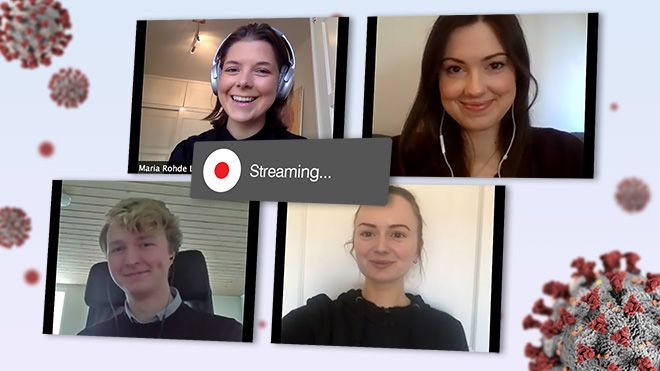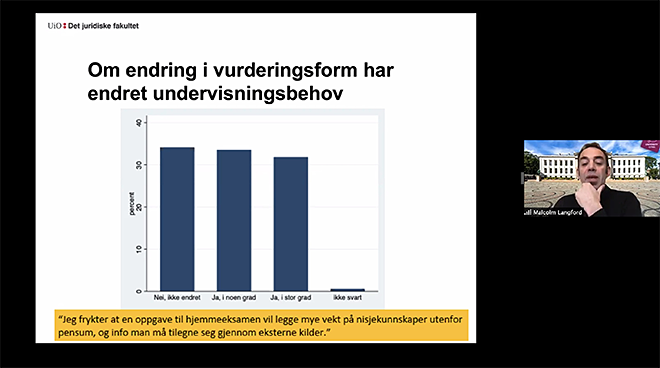Most law students at the University of Oslo (UiO) find that digital teaching provides good learning outcomes, and they want to have more of it. They want more real-time teaching and more interactive digital teaching, with greater opportunities for asking questions, discussing and collaborating. At the same time, students point to a number of factors they believe need to be improved upon for digital teaching.

Illustrasjonsfoto: UiO.
The Faculty of Law at UiO and the Centre for Experential Legal Learning (CELL) were very quick to introduce fully digital teaching for their students when the coronavirus led to the closure of the university on 12 March. As early as the next day, lecturers offered students lessons on digital platforms in the form of recorded lessons, virtual teaching in real time, group work and tutorials.
CELL were also very quick to gather first impressions from the students, and research what they think of the new teaching methods. On Monday 30 March, CELL published a report on how law students have experienced completely digital education for the very first time.
First impressions
The report "The first week of digital teaching during the coronavirus: The experience of law students" is authored by Malcolm Langford, Crina Damsa, Johanne Marie R. Larsen, Kristine S. Slåttå, Hilde Westye and Sophia S. Straub Wulff. It is based on the experiences of 175 law students after the first week of exclusively digital teaching, gives a qualitative and quantitative analysis of the students' answers, and summarises a number of findings and recommendations.
Among other things, the report shows that although the vast majority of students received an offer of digital teaching in the first week, students do not share the same experiences. Most students were offered several interactive forms of digital teaching in the first week after UiO's buildings were closed, while some received only one, or none at all.
The students are hoping for more diverse digital teaching, and they are deeply divided on whether the new forms of assessment introduced due to the pandemic change teaching needs. Half of the students also reported that they miss contact with the subject teacher and fellow students, and the majority of students responded that they rate their study situation in the first week of exclusively digital teaching as poor.
Important discoveries and some surprises
Most students found that they had received enough information in general, but they pointed out that the flow of information could be improved. The logistics of studying at home, the lack of functioning technical equipment and the home situation in general were also challenging for several students for the first week of digital teaching.
However, one of the report's most important findings is about the educational facilitation of digital teaching, as summarised by CELL's director, Malcom Langford:
- Good digital teaching is about dividing learning into smaller and specific parts, and ensuring that some of the teaching is in real time and interactive. The survey shows a clear correlation between live teaching and the assessment of individual learning experience. Many students were aware of this and commented on it in the survey.
- Are there any surprises in the report?
- That 60% thought that digital teaching was similar to or better than their usual lessons. This is much higher than anticipated after such an abrupt transition. It shows that many student organisations that have wanted more digital education may be right, Langford continues.
- At the same time, 40% believed the opposite. This is partly due to the extraordinary situation of the lockdown. But we need to ensure that we also adapt for students who are less happy about this form of teaching. When the coronavirus pandemic is over, we need to find the right balance between digital and physical means of teaching.
- What do you think are the biggest challenges ahead? Are there any obvious adjustments that you see the need for?
- The biggest challenge right now is the restrictions imposed due to the corona crisis. A substantial minority of students are struggling with childcare, illness, poor internet connection, lack of workspace at home and lack of contact with teachers and fellow students. There is a strong correlation between the number of challenges and how the student evaluates their learning experience and study situation.

- How will you meet the challenges pointed to in the report?
- Some challenges can only be addressed by the government, for example childcare or lack of income. But the faculty can adapt the teaching to suit the needs of the students. This applies to everything from interactivity in teaching to reassurance that the forms of assessment during the coronavirus pandemic are appropriate. We also need to make sure that employees have enough time to adjust, and we have some recommendations in the report about this.
More criticism was expected
Associate Professor Stian Øby Johnsen is the person with academic responsibility for digital teaching at the faculty. He says that he had expected more criticism from the students:
- My main thought is that the findings indicate that the students across the faculty have positive experiences from the first week of digital teaching. Although there is of course some criticism here and there, I had really expected far greater dissatisfaction, especially considering that this evaluation applies only to the first week. At the same time, we need to be a little cautious about the use of these findings, as they are only based on the first week of digital teaching.

- The first week will of course be more chaotic than the following weeks once teachers have had time to prepare for and practise teaching digitally. Additionally, it may be possible that the students' tolerance for any technical, practical and/or other problems is greater in a first week like this than it will be once digital learning has become part of our routines. This means that students may become more critical of the format in the future.
Much to be proud of
- What do you think has worked best up till now? What are you proud of?
- There is a lot to be proud about these days, I think. In particular, I want to highlight the teaching faculty, who have shown a surprisingly good ability in adapting to the new, digital work norms. Personally having the responsibility for digital teaching, I had expected literally hundreds of enquiries from teaching staff who felt helpless or lost, but that hasn't been the case. The academic and faculty staff have embraced their responsibilities in a brilliant way, ensuring that lecturers in pretty much every subject have come together for a common cause, and made sure to help each other with practical and technical challenges. For example, many groups of teaching staff have practised using Zoom together.
- I am also proud of the students, who, despite the many challenges the report points to, are participating in at least as many numbers as they did in our physical classrooms. My impression is that they are giving a very solid effort despite the fact the study situation is not optimal for very many of them.
New experiences
One of the educators who has had to jump straight into teaching the students in a fully digital way is the Associate Professor Anine Kierulf:
- I had never taught digitally before, but I took a recording in the classroom on the first day of the lockdown, and after that, with help from Stian Ø. Johnsen, on Zoom. It works well, thanks in large part to the students' positive attitudes.
Sophia Susanne Traub Wulff is a co-author of the report, but is also a law student.
- What I have noticed with the survey is that the vast majority are satisfied with the digital teaching that has taken place. At the same time, there are some who noted that they think the study day is more demanding now - several expressed that they felt lonely, are worried, and are more stressed than before. This is a worrying aspect of the situation we are in right now. I think that it is important that the faculty take this seriously and try to establish teaching in a way that can prevent loneliness and minimise stress, in addition to assisting students with the technology so that everyone can participate in digital learning.
- What do you think of the transition to fully digital teaching?
- The transition to digital teaching has surprised me in a positive way. There have naturally been some technical challenges, especially at the beginning, but all in all I am satisfied with the digital course teaching I have received. The only thing I miss is a simpler and clearer way to be able to ask a question to lecturer.
- How can this change to teaching be even better in the years to come?
- I think that the 'forced' transition to digital education that we are experiencing now can help clear the way for digital teaching in the future. For example, allowing a lecturer to deliver the course from home if for various reasons they need to stay there for the day, instead of cancelling or moving the course to a later date.
Super efficient work
CELL have been active from the first day of the transition and have: digitally supported the faculty with their work; taken responsibility for student resources, including English speaking students; created a national Facebook group for the entire higher education sector in Norway (which now has over 3500 members); and run 12 national webinars on digital teaching (where many of the faculty have also participated).
- Malcolm Langford, in this time of crisis with so much to do, how have you found time to evaluate digital teaching and prepare a report so quickly?
- Teamwork. Teamwork. Teamwork. In the last year, we at CELL have built an organisation with clever and keen academic and administrative staff and students. We also received help with this report from the education researcher Crina Damsa at LINK, and the faculty administration have helped with distributing the survey. We also had 90 participants at the digital launch! Everyone works quickly and efficiently together, with the overall goals of improving the quality of law education, and shining a light on teaching in the higher education sector. This collective effort has been going strong for the last 18 days. They are an incredible bunch to work with.
The Vice-Dean for Studies, Tarjei Bekkedal, has also stated in a press release from the faculty that he thinks the report is valuable to the faculty:
- The report provides knowledge that allows us to make adjustments to the digital teaching system. We've also gleaned more knowledge about effective digital teaching, even if the transition to digital teaching has taken place under unique and difficult circumstances.






